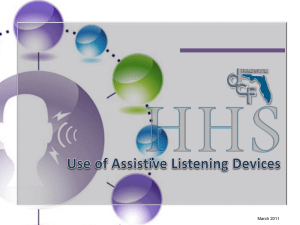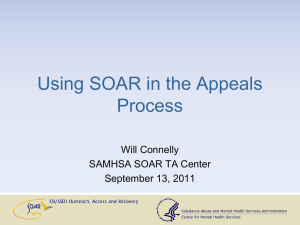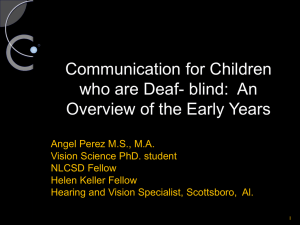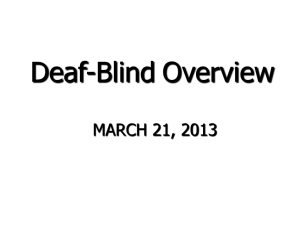Eligibility of a Child with Hearing Impairment, Including Deafness
advertisement
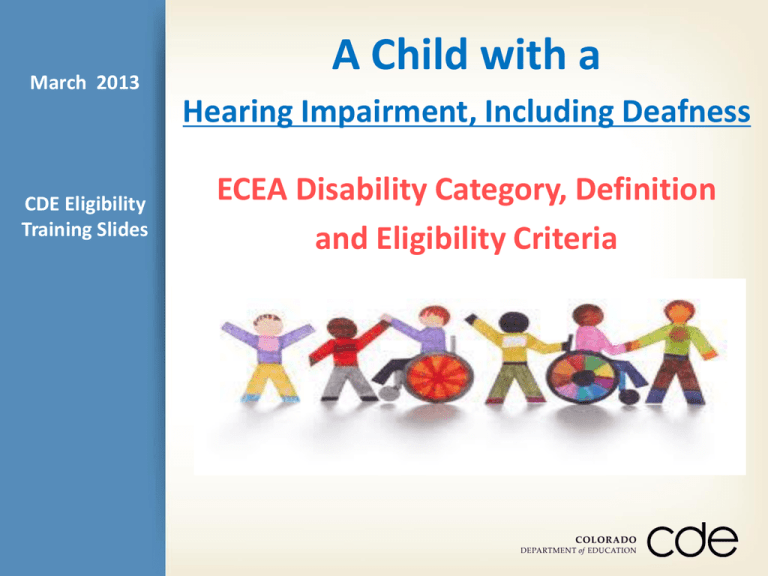
March 2013
A Child with a
Hearing Impairment, Including Deafness
CDE Eligibility
Training Slides
ECEA Disability Category, Definition
and Eligibility Criteria
Together We Can
Vision
All students in Colorado will become educated and
productive citizens capable of succeeding in a globally
competitive workforce.
Mission
The mission of CDE is to shape, support, and safeguard a
statewide education system that prepares all students
for success in a globally competitive world.
2
Hearing Impairment,
Including Deafness
The following slides have been vetted internally within the
Colorado Department of Education for training purposes of the
definition and eligibility criteria for Hearing Impairment,
Including Deafness.
If you make any changes to these slides, please acknowledge
that they are different from this vetted product and may no
longer represent the viewpoint of the CDE.
3
Eligibility Checklist for Hearing
Impairment, Including Deafness
It is recommended that the following training slides be used in
conjunction with the post-HB11-1277 Eligibility Checklist for a
Child with Hearing Impairment, Including Deafness, which can
be found at:
http://www.cde.state.co.us/cdesped/IEP_Forms.asp
4
HEARING IMPAIRMENT / DEAFNESS
Hearing Impairment, Including Deafness
(formerly Hearing Disability)
Ruth Mathers
5
mathers_r@cde.state.co.us
(303) 866-6909
2.08 (2) A child with Hearing Impairment, Including Deafness shall
have a deficiency in hearing sensitivity as demonstrated by an
elevated threshold of auditory sensitivity to pure tones or speech
where, even with the help of amplification, the child is prevented
from receiving reasonable educational benefit from general
education.
2.08 (2) (a) A "deficiency in hearing sensitivity" shall be one of the
following as measured by behavioral or electrophysiological
audiological assessments:
2.08 (2) (a) (i) Three frequency, pure tone average hearing loss in
the speech range (500 – 4000 Hertz {Hz}) of at least 20 decibels
Hearing Level (dBHL) in the better ear which is not reversible.
2.08 (2) (a) (ii) A high frequency, pure tone average hearing loss of
at least 35 dBHL in the better ear for two or more of the
6
following frequencies: 2000, 3000, 4000 or 6000 Hz.
2.08 (2) (a) (iii) A three frequency, pure tone average unilateral
hearing loss in the speech range (500 – 4000Hz) of at least 35
dBHL which is not reversible.
2.08 (2) (a) (iv) A transient hearing loss, meeting one of the criteria
in (a)(i) – (a)(iii) above, that is exhibited for three (3) months
cumulatively during a calendar year (i.e., any three months
during the calendar year) and that typically is caused by nonpermanent medical conditions such as otitis media or other ear
problems.
2.08 (2) (b) The Hearing Impairment, Including Deafness, as
described above, prevents the child from receiving reasonable
7
educational benefit from general education as evidenced by
one or more of the following:
2.08 (2) (b) (i) Delay in auditory skills and/or functional auditory
performance including speech perception scores (in quiet or
noise), which demonstrates the need for specialized
instruction in auditory skill development or assistive
technology use;
2.08 (2) (b) (ii) Receptive and/or expressive language (spoken or
signed) delay including a delay in syntax, pragmatics, semantics,
or if there is a significant discrepancy between the receptive and
expressive language scores and/or function which adversely
impacts communication and learning;
8
2.08 (2) (b) (iii) An impairment of speech articulation, voice
and/or fluency;
2.08 (2) (b) (iv) Lack of adequate academic achievement
and/or sufficient progress to meet age or state-approved
grade-level standards in reading, writing, and/or math;
2.08 (2) (b) (v) Inconsistent performance in social and learning
environments compared to typically developing peers;
and/or
2.08 (2) (b) (vi) Inability to demonstrate self advocacy skills or
utilize specialized technology/resources to access
instruction.
9
To Be Eligible as a Child with Hearing
Impairment, Including Deafness
2.08 (2) A child with Hearing Impairment, Including Deafness shall have
a deficiency in hearing sensitivity as demonstrated by an elevated
threshold of auditory sensitivity to pure tones or speech where,
even with the help of amplification, the child is prevented from
receiving reasonable educational benefit from general education.
~~This rule sets out the two required components for eligibility under
Hearing Impairment, including Deafness; (1) an identified hearing loss (2)
the child’s inability to be educated in general education due to the impact
of the hearing loss.
• A diagnosed hearing loss does not automatically guarantee a
child’s eligibility for special education services
10
GLOSSARY
~~deficiency in hearing sensitivity - a hearing loss
~~elevated threshold - refers to an increased decibel level as
indicated on an audiogram. The range -10dB to +15dB is
considered normal hearing. Any decibel threshold “elevated”
beyond 20dB indicates a hearing impairment.
~~pure tones – tones at selected
pitches (frequencies measured in
Hertz [Hz]) from low to high.
Much like a piano keyboard, the
low tones are to the left and the
high tones are to the right.
~~amplification – hearing aids,
cochlear implants, FM systems,
etc.
~~amplification – hearing aids, cochlear
implants, FM systems, etc.
Cochlear Implants
2.08 (2) (a) A "deficiency in hearing sensitivity" shall be one of the
following as measured by behavioral or electrophysiological
audiological assessments:
~~An example of behavioral assessment is behavioral response audiometry
measures, such as Play Audiometry
~~Examples of electrophysiological assessments are: Otoacoustic Emissions (OAE)
and Auditory Brain Stem Response
~~Only one of subsections (i) – (iv) is required to determine a hearing impairment
2.08 (2) (a) (i) Three frequency, pure tone average hearing loss in the
speech range (500 – 4000 Hertz {Hz}) of at least 20 decibels
Hearing Level (dBHL) in the better ear which is not reversible.
2.08 (2) (a) (ii) A high frequency, pure tone average hearing loss of at
least 35 dBHL in the better ear for two or more of the following
frequencies: 2000, 3000, 4000 or 6000 Hz.
~~The addition of 3000 and 6000 Hz are in response to improved technology
14
2.08 (2) (a) (iii) A three frequency, pure tone average unilateral
hearing loss in the speech range (500 – 4000Hz) of at least 35
dBHL which is not reversible.
~~The new language clarifies audiologic specificity for identifying a
unilateral loss
2.08 (2) (a) (iv) A transient hearing loss, meeting one of the criteria
in (a)(i) – (a)(iii) above, that is exhibited for three (3) months
cumulatively during a calendar year (i.e., any three months
during the calendar year) and that typically is caused by nonpermanent medical conditions such as otitis media or other ear
problems.
~~A transient hearing loss is a chronic condition where hearing
level fluctuates and can be proven to impact the child’s
language and/or academic development. Note that the three
month time period is not required to be consecutive.
15
Specially Designed Instruction
“Specially Designed Instruction" means adapting, as
appropriate to the needs of an eligible child, the content,
methodology or delivery of instruction to address the child's
unique needs resulting from the disability and ensuring the
child's access to the general curriculum so that he or she can
meet the educational standards that apply to all children within
jurisdiction of the public agency. 34 CFR 300.39 (b)(3).
It involves providing instruction that is different from that
provided to children without disabilities, based upon the eligible
child’s unique needs.
16
(HID): The Child Cannot Receive
REB from General Education
2.08 (2) (b) The Hearing Impairment, Including Deafness, as
described above, prevents the child from receiving reasonable
educational benefit from general education as evidenced by
one or more of the following:
2.08 (2) (b) (i) Delay in auditory skills and/or functional
auditory performance including speech perception scores (in
quiet or noise), which demonstrates the need for specialized
instruction in auditory skill development or assistive
technology use; and/or
17
~~Specialized instruction might include listening therapy during
academic instruction or in a small classroom environment, audiologic
intervention to learn how to utilize a device, etc
(HID): The Child Cannot Receive
REB from General Education
2.08 (2) (b) (ii) Receptive and/or expressive language (spoken or
signed) delay including a delay in syntax, pragmatics,
semantics, or if there is a significant discrepancy between the
receptive and expressive language scores and/or function
which adversely impacts communication and learning; and/or
2.08 (2) (b) (iii) An impairment of speech articulation, voice
and/or fluency; and/or
2.08 (2) (b) (iv) Lack of adequate academic achievement and/or
sufficient progress to meet age or state-approved grade-level
standards in reading, writing, and/or math; and/or
18
(HID): The Child Cannot Receive
REB from General Education
2.08 (2) (b) (v) Inconsistent performance in social and learning
environments compared to typically developing peers;
and/or
2.08 (2) (b) (vi) Inability to demonstrate self advocacy skills or
utilize specialized technology/resources to access
instruction.
~~Subsections (v) and (vi) are new rules for considering a child’s
eligibility for Special Education services.
19
In the Event of Deaf-Blindness
If the child with Deaf-Blindness does not meet the exact
eligibility requirements for Hearing Impairment, Including
Deafness (HID), but the combination of an existing hearing loss
and the documented vision loss adversely affects the student’s
educational performance that will prevent the child from
receiving reasonable educational benefit from general
education, there is a box on the HID eligibility checklist page
for this situation.
20
To Be Eligible as HID, the Child
Must Meet All Three Conditions
1. Have evidence of a deficiency in hearing sensitivity, as
measured by behavioral or electrophysiological audiological
assessment conducted by an audiologist.
2. The deficiency of hearing sensitivity must be significant
enough that even with the help of amplification, educational
performance is adversely affected.
3. The deficiency of hearing sensitivity must create a need for
specially designed instruction.
21
Thank You!
22





